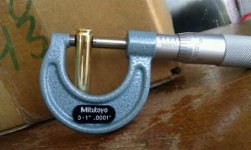R
RAG2
Guest
Probably going to have a reamer made up for a 20 Tac I'm going to put on my BAT varmint rig. Have dies, brass and bullets. I took some multiple fired .223 brass and ran it through my Redding 20 TAC Type S bushing die...the brass was squeezed down to .3743 at the base and .3573 at the shoulder. So I was thinking a reamer with base of .375 and .359 at the shoulder would be about right. But I don't know. I forget how much bump I get from my Harrels dies, but they always seem to work out so well.
The neck is easy...I'm not going to turn, and loaded rounds (Dakota/Lapua brass) range from .230 to .231 (with most right around .2305), so I'm going to go with the "standard" .233 neck (or I could go with .2325 if I want to split hairs, giving and average clearance of .002 and no less than .0015).
Thanks!!!
The neck is easy...I'm not going to turn, and loaded rounds (Dakota/Lapua brass) range from .230 to .231 (with most right around .2305), so I'm going to go with the "standard" .233 neck (or I could go with .2325 if I want to split hairs, giving and average clearance of .002 and no less than .0015).
Thanks!!!
Last edited by a moderator:


